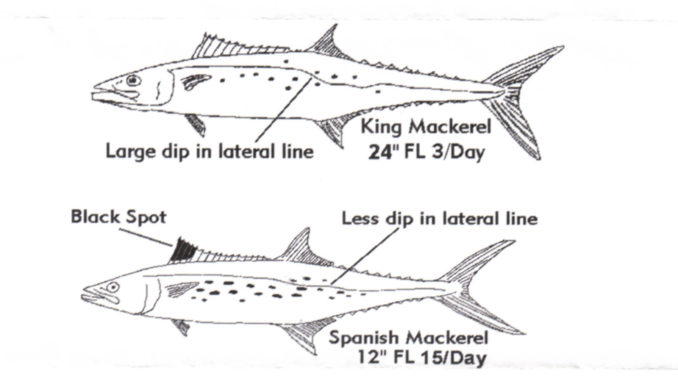
Don’t make costly mistake thinking a small king is a big Spanish
Is that a king mackerel of a Spanish mackerel you’re about to slide into your cooler? It might not quite be the $64,000 question, but it is one that could be expensive for fishermen if they make the wrong guess. The cost of court for having an undersize king mackerel is significant, and there is always the possibility of a hefty fine.
Unfortunately, every year at this time, schools of small kings and large Spanish are feeding in the same areas and are often caught together. Fishermen must learn to tell the difference as Spanish mackerel only have a 12-inch (fork length) minimum size and the limit is 15, while king mackerel have a 24-inch (fork length) minimum size and the limit is three fish.
Large Spanish mackerel and small king mackerel resemble each other closely. They have the same basic body shape, and Spanish mackerel have spots, while small king mackerel may have spots.
Some fishermen confuse themselves even more by adding cero mackerel to the list and calling any mackerel they are undecided about a cero mackerel. That may work for family, neighbors and fishing buddies, but the marine patrol officer checking your catch will quickly tell you there aren’t cero mackerel in the Carolinas – and he is correct.
“There are several differences between large Spanish and small king mackerel,” said Randy Gregory of the N.C. Division of Marine Fisheries. “Their lateral lines drop differently, with Spanish having a gradual drop along their entire length and Kings having a sharp drop just behind the rear dorsal fin, but the difference is sometimes hard to see at this size. The easiest and most reliable way to tell the difference between Spanish and kings is to look at their forward dorsal fin. If there is a black spot on the front of the forward dorsal fin, it is a Spanish mackerel, and if the dorsal fin is gray from end to end, it is a king mackerel.”
Gregory said the black spot on the front dorsal fin is what a marine patrol officer will check to determine which mackerel it is, and he warned fishermen against making a potentially expensive mistake. Check your catch the same way biologists and marine patrol officers do. Know which fish you have and keep up to your limit of Spanish and kings to enjoy several meals of fresh fish.




Be the first to comment